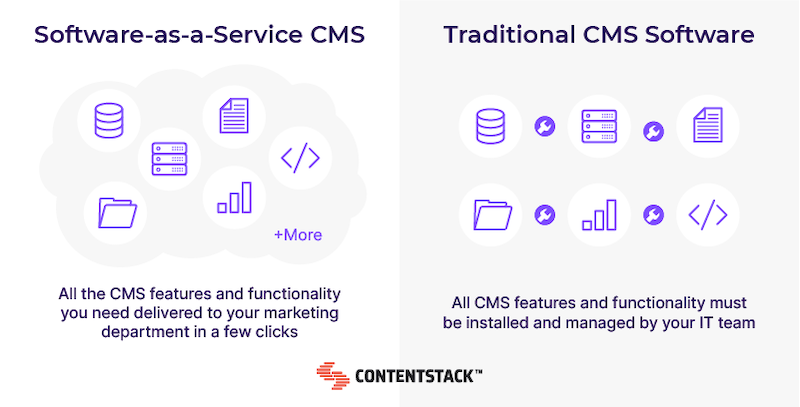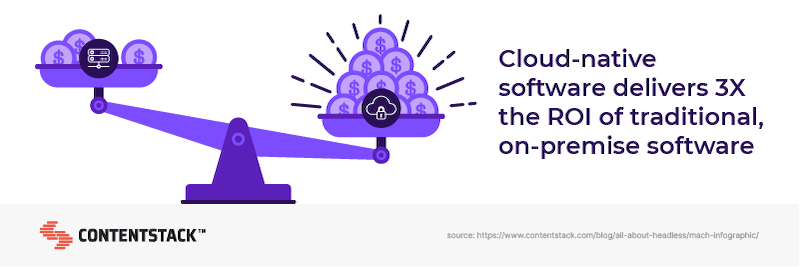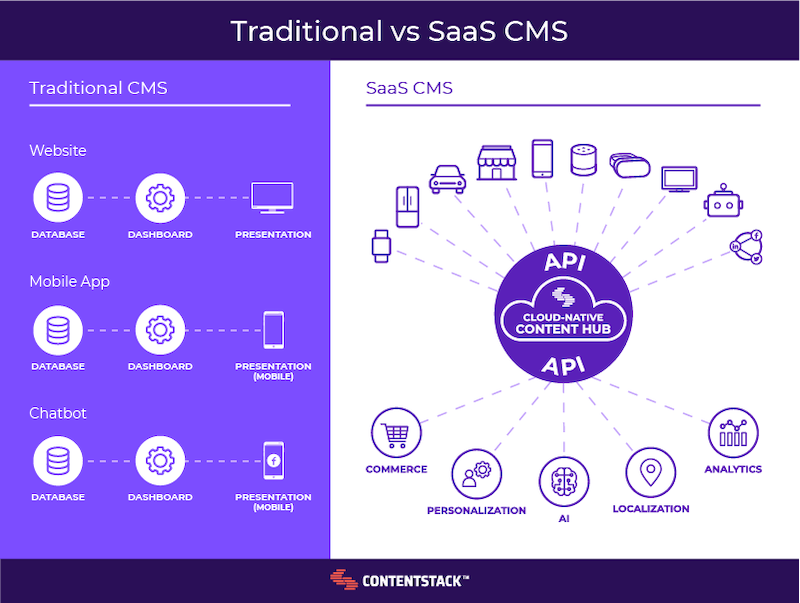Originally known as the “time-sharing system,” what we call now software-as-a-service (SaaS) dates back more than 50 years. For instance, the IBM 7090 that NASA used to control space flights in the 1960s was rented for $500,000 per month (in today’s money). What started as a solution for companies that didn’t have the space or the resources to purchase their own computers turned out to be an ideal arrangement for many other reasons.
Whether you’re responsible for purchasing and maintaining your organization’s technology or for improving the content features to which your marketing team has access, SaaS is typically a smart choice. It’s generally easier to use and maintain, more affordable, more powerful, and simply more modern than its traditional on-site counterpart.
Interested in learning more about SaaS for content management and how you can start making the transition from legacy, on-premise software to SaaS? Then you’ve come to the right place. No $500,000 monthly rent required.
What Separates SaaS CMS From Traditional CMS?
Instead of being downloaded to your company’s computers and maintained by your IT team, software-as-a-service is hosted in the cloud and delivered to customers via the internet by a vendor, who maintains the software on their end. Typically, the most maintenance that you should have to do with software delivered as a service is keep paying the subscription.
When it comes to a content management system (CMS), the “traditional” way to work with CMS software is to purchase a license and use your own server space to host the files that make up the CMS. Traditional CMS users may also pay a hosting company to store their CMS files off-site. Maintenance with a traditional CMS requires updating the software on a regular basis to keep functionality and security up to snuff, as well as installing any plug-ins needed to increase its capabilities.
Then there’s the modern SaaS CMS, which is widely considered easier to manage than traditional CMS. SaaS CMS vendors maintain and host the software they sell. That means your team doesn't have to spend any time or server space on hosting and very little, if any, on CMS upkeep and maintenance. As times and trends change, the cloud-native content management provider is the one best equipped to add and subtract features—simply delivering them to clients via the cloud in the next update.

Benefits of SaaS CMS Over Traditional CMS
Let’s explore some of the key advantages that differentiate today’s modern SaaS CMS from the traditional CMS platforms of old.
Composable Features Make for Increased Functionality
With a traditional CMS, the problem is not finding a solution that meets your needs. The problem is that you’ll never find one that can evolve and be rearranged the way a SaaS CMS can when your needs inevitably change.
SaaS CMS providers understand that a major benefit of cloud-native content management software is that updates are handled on their end. So now that the technology is available, these providers have built their SaaS tools on modern composable platforms so that content features are easy to add, remove, update, and deliver to the buyer as trends and technology change.
Flexible Content Management Capabilities
What do highly-composable features mean when it comes to cloud-native content management? Modern, flexible content management capabilities that empower modern, flexible marketing campaigns.
Today’s marketing users need rich content controls that enable smooth content creation and collaborative workflows and integrations with the other tools (think CRMs, analytics platforms, and more) that make your marketing program tick. Together, these features make omnichannel distribution as easy as the click of a button. Thanks to their composable nature, modern SaaS CMS can deliver on all your current content channels and adapt to drive new channels and opportunities that will emerge.
On-Demand Scalability
Most large businesses and marketing departments want to grow. That’s a given. What isn’t so obvious is how to be ready for that growth. Before cloud-native content management software, traditional CMS users had two options: Consistently overpay for the features and bandwidth you hope you’ll eventually need—or be caught unprepared to scale when the pivotal moment of growth arrives. We’ve all seen the latter happen to businesses after a popular commercial or media mention drives unforeseen traffic and crashes a website.
With a SaaS CMS, the vendor manages all hosting and storage needs. That means they can see when a wave is coming and scale up your server space accordingly before it hits. Sure, you’ll have to pay for your increased server usage, but you only pay for exactly what you need when you’re actively using it. If traffic scales back down for any reason, your cost does as well.
Dependable Uptime and Availability
By nature, SaaS CMS vendors are one part content management feature builders and one part hosting pros. This is because they know that a key reason marketing technology buyers purchase their product is so that they can access their CMS anywhere in the world and at any time. In fact, one LinkedIn study found that the most “essential” characteristic of SaaS technology is availability.
Being able to promise dependable uptime and therefore availability is a major differentiator for cloud-native content management software.

Reliable Backup
Off-site hosting means your files and data will be safe and sound if anything should happen to your on-site premises or technology. Natural disaster? You won’t have to worry about local events impacting your SaaS CMS when your files and data are all stored safely in the cloud. And if something like a security breach does knock out your CMS momentarily, you can get back online quickly thanks to the reliable digital backup that a cloud-native content management system provides.
Lower Cost Than Traditional CMS Software
The cost savings abound when it comes to SaaS CMS. First, there are the more obvious cost reductions compared to traditional CMS—no on-site servers or other hardware, no development time spent on building or upgrading features, etc. Then there are the unseen savings, such as on the opportunity costs that come with a lack of scalability, the downtime during updates, security and service breaches, and other issues tied to traditional CMS.
Faster Collaboration and Time to Market
What do flexible content management features, dependable scalability, and wide-spread availability have in common? They enable marketing teams to use SaaS CMS to collaborate more effectively, no matter what device they’re using or where they’re working. Now that COVID-19 has made remote work likely to become a lasting reality for many organizations, this benefit will have more impact than ever.
This level of collaboration means those marketing campaigns your team is working so hard to create can get to market more quickly—giving you yet another way to get a leg up on the competition.
Make the Most of Your Switch to SaaS CMS by Going Headless
While SaaS CMS is a modem upgrade when compared to traditional CMS software across the board, not all cloud-native content management systems are created equal. To make your switch to SaaS CMS a success, we recommend you select a headless CMS solution.
What is headless CMS?
Headless content management systems rely on modular architecture to disentangle content creation and management from the design and development that goes into publishing it on various channels and devices.
This decoupling process means marketers can publish their content campaigns to various platforms while designers create engaging content displays and IT pushes technology updates. A headless CMS enables every team in the content publishing process to work independently yet in sync.

And why headless CMS instead of another type of SaaS CMS? Because the right headless CMS solution will be MACH-powered.
MACH is a term for modern composable technology that’s enabled by a unique combination of features:
- Microservices are single-purpose applications that can be maintained and scaled independently, providing infinite content management capabilities.
- Application programming interface (API) technology enables composable architecture by connecting all of these microservices together.
- Cloud-nativity means your SaaS CMS is delivered by a vendor who takes care of all the hosting and upgrades, as we mentioned earlier.
- Headless architecture is the final piece of the puzzle, decoupling the content presentation layer from the database for limitless integrations and omnichannel content delivery.
MACH makes for a modern, headless CMS that is quick and easy to scale, update, and integrate with so your marketing team can keep delivering on quickly-changing digital experiences.
To keep learning more about the exciting new world of MACH marketing technology, check out our infographic “MACH to the Rescue”. And to see how your team can benefit from working within a headless, MACH-powered, SaaS CMS —click here to request a detailed demo today.
